Some photos of Dahlonega, Georgia, the site of a United States mint
Last week I visited Dahlonega, Georgia which was the site of a United States mint from 1838 to 1861. I had visited the area more than ten years ago, and I was surprised at the changes that had been made.
The old courthouse, which was built in 1836, is now “The Gold Museum” as it was ten years ago. There had been quite a number of changes to the interior including the historical displays. Last time I swear that had been a complete set of Dahlonega gold coins all in PCGS holders, or maybe I just dreamed it. The presentation had not been the best, but at least you could look at the coins in the front in some detail. Now there is a Dahlonega gold set in a Capital Plastics holder. It is way in the back of the safe, and you can barely see the coins.
Although you could take photos everywhere else in the museum, you could not take pictures of the contents of the safe. In reality to the picture would have been of little use anyway.
Here are photos of the exterior of the Gold Museum.
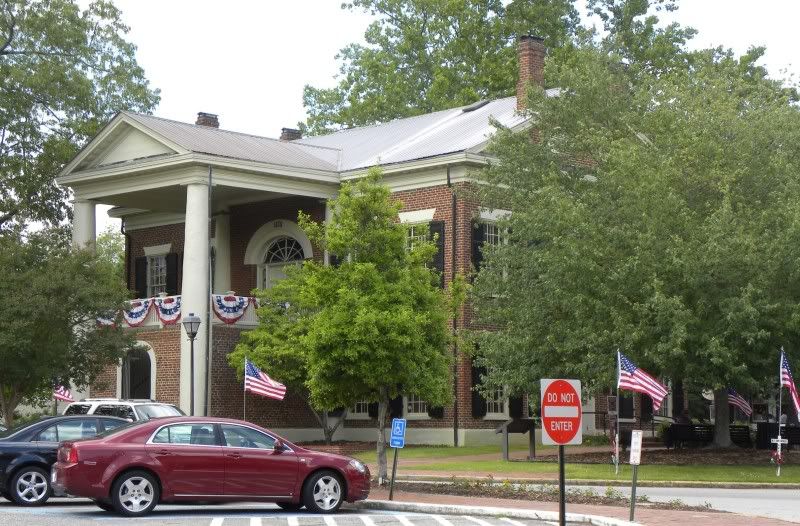
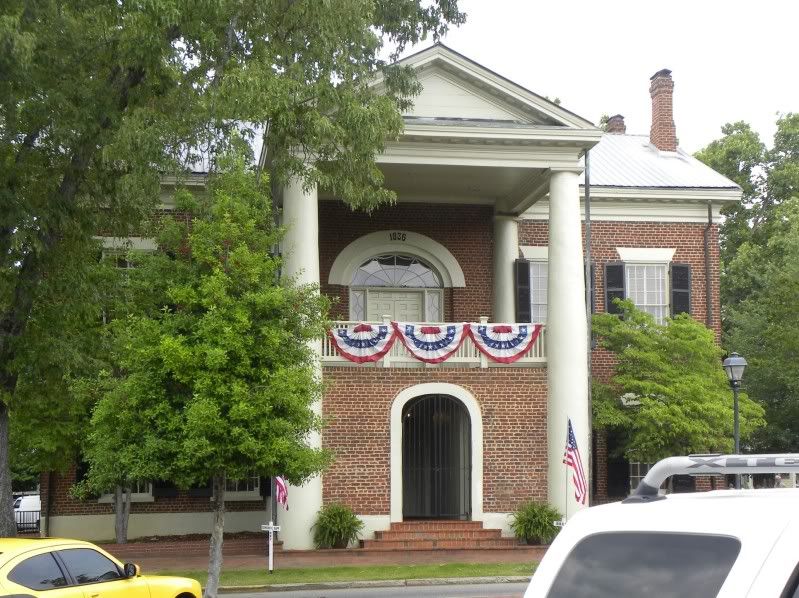
The Dahlonega phase of the southern gold rush began in 1828 when as legend has it a man named Benjamin Parks kicked an unusual stone while he was walking in the woods. He determined that it was gold, but was unable to keep the lid on his discovery for very long. Once word spread gold prospectors flocked to the area to strike it rich in what became the first United States gold rush.
The rights to 40 acre plots of land that might contain gold were distributed by a lottery. The lucky winners were allowed to either work their claim or sell it. The big losers were the Cherokee Indians who were forced from their lands and driven west in what became known as “the trail of tears.” Here is one of the 40 acre deeds that that were issued to one of the winners of the lottery.
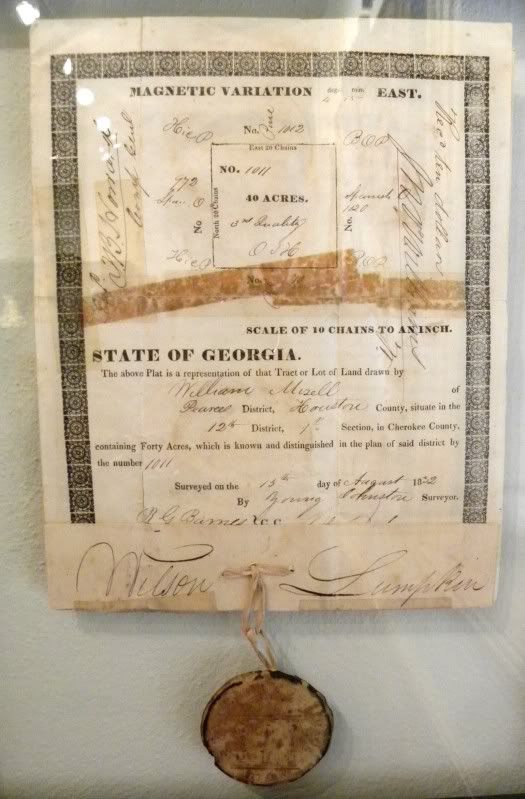
The need to refine the native gold and have it turned into coins was acute. Transportation of gold from the southern goldfields to the Philadelphia mint involved a long and dangerous round trip, which sometimes involved encounters with bandits and “wild Indians.” To fill the gap Templeton Reed and more importantly, the Bechtler family, provide privately mints coins, but a Federal mint was needed. Ultimately Congress authorized mints in Charlotte, North Carolina and Dahlonega, Georgia to serve the southern gold fields. Congress also established the New Orleans mint to convert gold and silver foreign coins that passed through that port city to United States coinage.
The Dahlonega mint was located on a hill that overlooked the town. Its first coinage was a mintage of 20,583 half eagles, one of which is shown below. The mint personnel took great pride in these pieces, which were well executed.
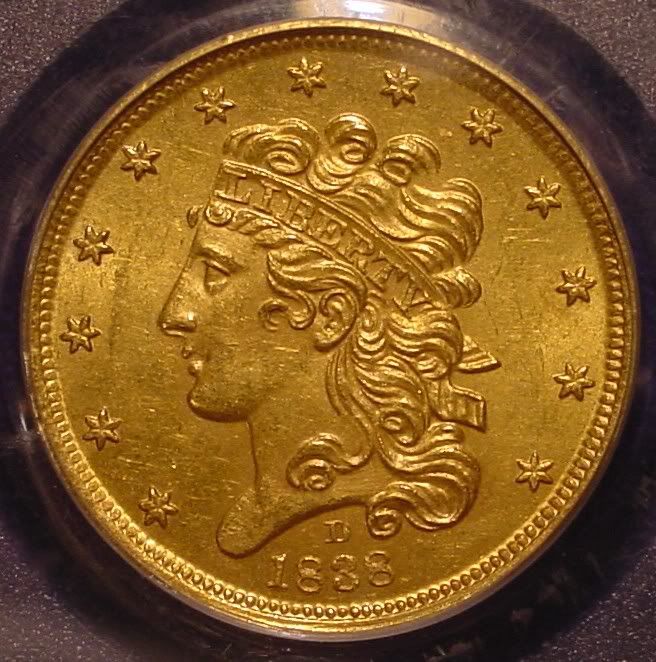
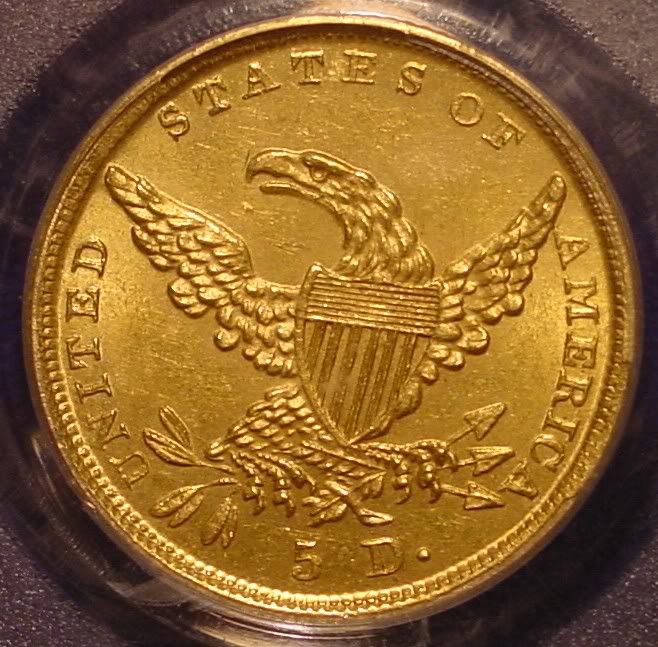
Soon after the mint opened it became obvious that the Dahlonega area goldfields were going to be hard pressed to produce enough metal to keep the mint viable. This lack of raw material would be an ongoing problem for the mint through out all of its years of operation. Here is a photo of Dahlonega mint taken circa 1877 after it became the home of the North Georgia Agricultural College.
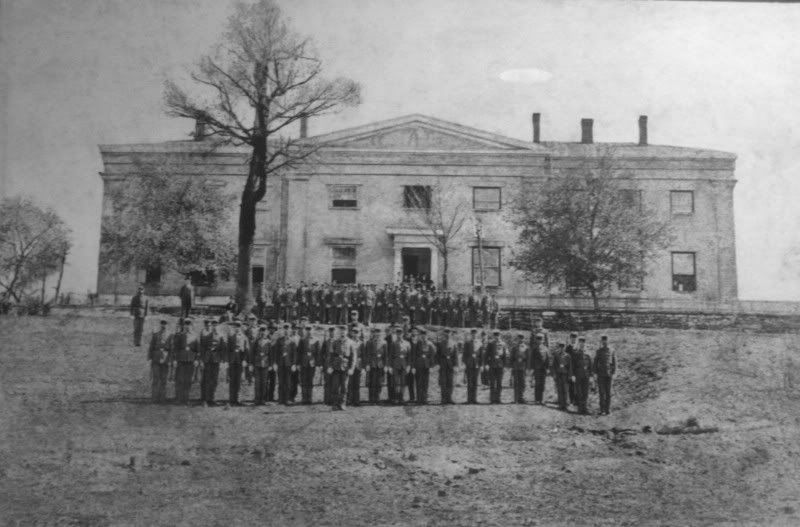
In 1861 the State of Georgia seized the mint after the state seceded from the Union at the beginning of the Civil War. The mint produced an unknown number of 1861-D gold dollars while it was under Confederate control, and then functioned as assay office and storage facility for the duration of the Civil War.
After the war some consideration was given to re-opening the mint or perhaps using it as a federal assay office, but none of those proposals were accepted. Ultimately it became the home of the Georgia Agricultural College.
On December 19, 1878 the structure caught fire and almost totally destroyed. Only the foundations could be saved, and they are now the basis for Price Memorial Hall, which is pictured below.
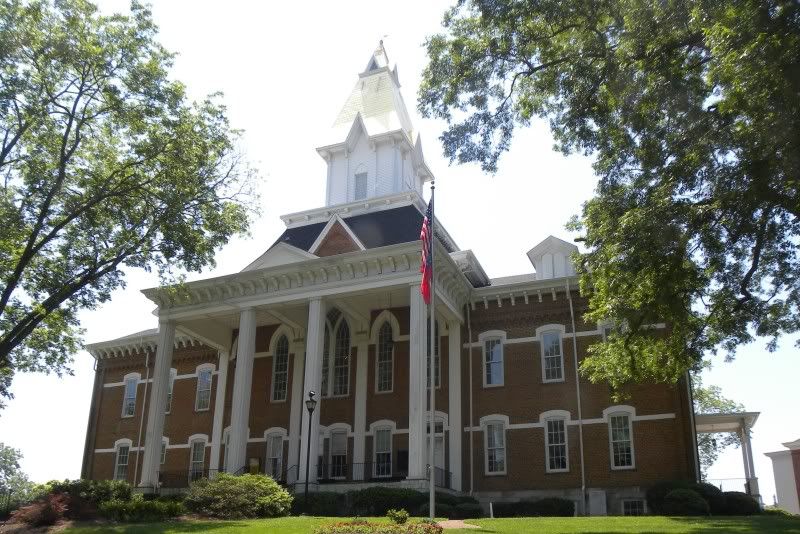
The granite foundation blocks of the old mint are still visible. There is also a tablet at the base of the building that provides a brief history of the mint.
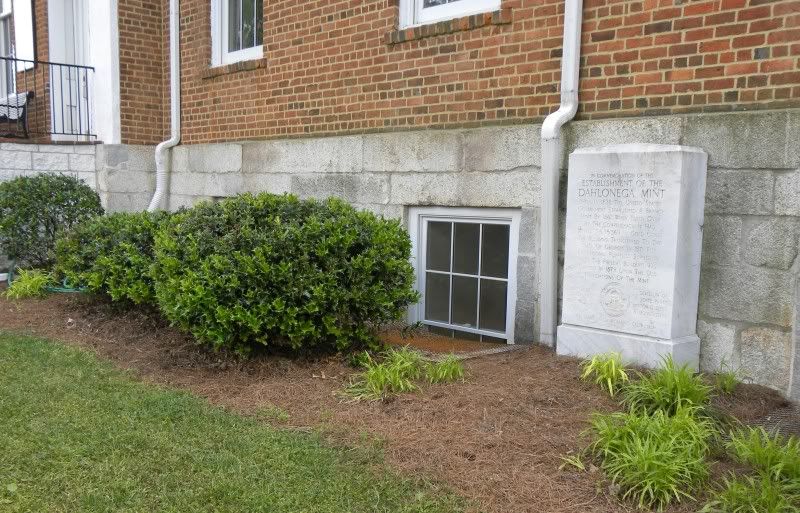
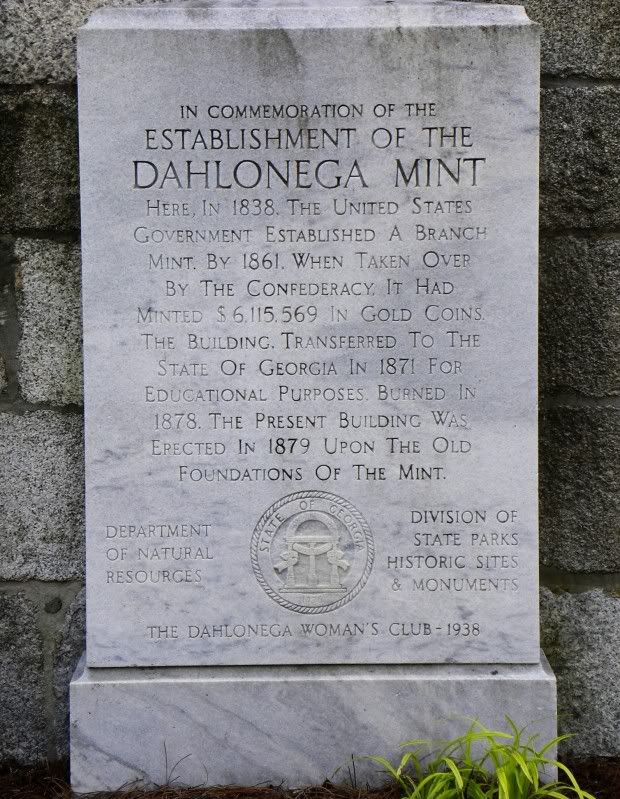
While I was taking these pictures I was fortunate enough to run into a professor who was kind enough to let me have a look at the inside of the building’s basement. There I saw this glassed in section of the inside of the foundation of the building. It was in this general area that the steam engine that ran the coin press and rolling operation of the mint was housed.
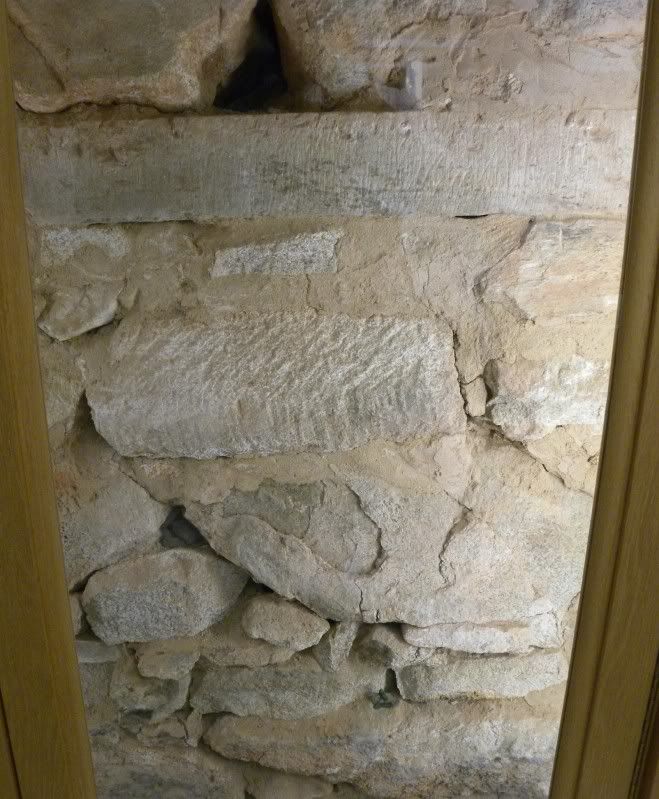
I have a lot more information, but perhaps it is time to open this post up to see if there is further interest.
The old courthouse, which was built in 1836, is now “The Gold Museum” as it was ten years ago. There had been quite a number of changes to the interior including the historical displays. Last time I swear that had been a complete set of Dahlonega gold coins all in PCGS holders, or maybe I just dreamed it. The presentation had not been the best, but at least you could look at the coins in the front in some detail. Now there is a Dahlonega gold set in a Capital Plastics holder. It is way in the back of the safe, and you can barely see the coins.
Although you could take photos everywhere else in the museum, you could not take pictures of the contents of the safe. In reality to the picture would have been of little use anyway.
Here are photos of the exterior of the Gold Museum.


The Dahlonega phase of the southern gold rush began in 1828 when as legend has it a man named Benjamin Parks kicked an unusual stone while he was walking in the woods. He determined that it was gold, but was unable to keep the lid on his discovery for very long. Once word spread gold prospectors flocked to the area to strike it rich in what became the first United States gold rush.
The rights to 40 acre plots of land that might contain gold were distributed by a lottery. The lucky winners were allowed to either work their claim or sell it. The big losers were the Cherokee Indians who were forced from their lands and driven west in what became known as “the trail of tears.” Here is one of the 40 acre deeds that that were issued to one of the winners of the lottery.

The need to refine the native gold and have it turned into coins was acute. Transportation of gold from the southern goldfields to the Philadelphia mint involved a long and dangerous round trip, which sometimes involved encounters with bandits and “wild Indians.” To fill the gap Templeton Reed and more importantly, the Bechtler family, provide privately mints coins, but a Federal mint was needed. Ultimately Congress authorized mints in Charlotte, North Carolina and Dahlonega, Georgia to serve the southern gold fields. Congress also established the New Orleans mint to convert gold and silver foreign coins that passed through that port city to United States coinage.
The Dahlonega mint was located on a hill that overlooked the town. Its first coinage was a mintage of 20,583 half eagles, one of which is shown below. The mint personnel took great pride in these pieces, which were well executed.


Soon after the mint opened it became obvious that the Dahlonega area goldfields were going to be hard pressed to produce enough metal to keep the mint viable. This lack of raw material would be an ongoing problem for the mint through out all of its years of operation. Here is a photo of Dahlonega mint taken circa 1877 after it became the home of the North Georgia Agricultural College.

In 1861 the State of Georgia seized the mint after the state seceded from the Union at the beginning of the Civil War. The mint produced an unknown number of 1861-D gold dollars while it was under Confederate control, and then functioned as assay office and storage facility for the duration of the Civil War.
After the war some consideration was given to re-opening the mint or perhaps using it as a federal assay office, but none of those proposals were accepted. Ultimately it became the home of the Georgia Agricultural College.
On December 19, 1878 the structure caught fire and almost totally destroyed. Only the foundations could be saved, and they are now the basis for Price Memorial Hall, which is pictured below.

The granite foundation blocks of the old mint are still visible. There is also a tablet at the base of the building that provides a brief history of the mint.


While I was taking these pictures I was fortunate enough to run into a professor who was kind enough to let me have a look at the inside of the building’s basement. There I saw this glassed in section of the inside of the foundation of the building. It was in this general area that the steam engine that ran the coin press and rolling operation of the mint was housed.

I have a lot more information, but perhaps it is time to open this post up to see if there is further interest.
Retired dealer and avid collector of U.S. type coins, 19th century presidential campaign medalets and selected medals. In recent years I have been working on a set of British coins - at least one coin from each king or queen who issued pieces that are collectible. I am also collecting at least one coin for each Roman emperor from Julius Caesar to ... ?
0
Comments
I wonder what that attached 'circle' is to the deed?
Freddie
PS...Nice half eagle too!!
Jade Rare Coin eBay Listings
<< <i>is that your half eagle or was that in the museum? >>
It's mine. I could not have gotten a photo like that from the way their piece was displayed.
<< <i>
<< <i>is that your half eagle or was that in the museum? >>
It's mine. I could not have gotten a photo like that from the way their piece was displayed. >>
is yours better anyway?
Looking for Top Pop Mercury Dime Varieties & High Grade Mercury Dime Toners.
<< <i>
<< <i>
<< <i>is that your half eagle or was that in the museum? >>
It's mine. I could not have gotten a photo like that from the way their piece was displayed. >>
is yours better anyway?
My piece probably is better. It is one of two pieces that PCGS has graded MS-63.
It's surprising that I saw three 1854-D Three Dollar gold pieces while I was there. Two were in the Gold Museum collection, and one was at the Crisson Gold Mine store.
<< <i>If I am not mistaken. Quite a bit of the collection was auctioned off quite a few years ago. I also remember them boasting 2 sets of Dalonega Coins many years ago. >>
Yes, that might be so. The guides at the Gold Museum said the set they are showing now came from the college where the mint building was located. The guides said that it had been in the library and that coins had been stolen from it, and at one time even the whole collection had been lifted.
I can’t believe that my memory is bad about the PCGS graded set. I also vaguely remember seeing a photo that someone here had taken of the interior of the safe with the PCGS graded coins showing.
At any rate what they have now is the one complete set in Capital Plastic, and another holder with a gold dollar, a quarter eagle, the 1854-D Three Dollar, and two half eagles in it. Since you can only see one side at a distance, grading is pretty much impossible
Worry is the interest you pay on a debt you may not owe.
"Paper money eventually returns to its intrinsic value---zero."----Voltaire
"Everything you say should be true, but not everything true should be said."----Voltaire
R.I.P. Bear
I enjoyed it very much.
Not my coin.
Terrific thread. And a gorgeous 38-D Half Eagle!
I seem to recall another post a year or two ago that had pics of their set of Dahlonega coins as they were displayed in a safe. ???
Please continue!!!
Thanks for sharing.
Here are some pics of the safe in the museum with the coins inside........CLICK HERE
I didn't know you weren't supposed to take pics, nobody said anything and no signs were present (it might be a new rule).
Too many positive BST transactions with too many members to list.
A reverse PROOF
a regular PROOF
a "D" bus strike
a no "D" bus strike
a double "D" bus strike
An Atlanta attorney donated a full set of Dahlonega gold to the State of Georgia in 1954. Ownership of the collection was transferred to North Georgia College (in Dahlonega) soon thereafter and was displayed in a "burglar-proof" case in the school's library, which was then located in the building next to Price Memorial Hall (the college's administration building), the latter having been built on the old mint's granite foundation.
The entire collection was stolen in March 1963 and the coins were never recovered. With the insurance policy proceeds, Stack's was commissioned to replace the set, which was accomplished in 1972. The coins were subsequently displayed in a Diebold case in Price Memorial Hall, in a Capital Plastics holder, where both sides of the coins were visible. When Price Memorial Hall was undergoing renovation in the mid-1990s, the set was temporarily loaned to the Gold Museum, so that the collection could remain on display. The arrangement proved to be beneficial for both parties, so the Gold Museum continued to have custodianship, even after Price Memorial Hall's renovation was complete.
I recall that a private collector had PCGS-certified coin(s) on display at the Gold Museum during this same time-frame (I remember a Templeton Reid gold piece, but there may have been Dahlonega and Bechtler pieces as well).
Larry L.
In 1849 the United States mint system began to issue the gold dollar. The people in the vicinity of the Charlotte and Dahlonega mints were pleased that this coin was now available to them because it allowed their facilities to stretch the dwindling production from their goldfields over a larger mintage. It was hoped that this would allow the southern mints to remain open.
The Dahlonega mint faced some challenges with producing the new coins because it did not have a milling machine that was capable of producing the tiny coins. Once the mint was able to begin the production, the 1849-D gold dollars had a distinctive look, but they were creditable coins. Here is an example of the 1849-D gold in MS-62.
The Dahlonega mint faced some challenges with producing the new coins because it did not have a milling machine that was capable of producing the tiny coins. Once the mint was able to begin the production, the 1849-D gold dollars had a distinctive look, but they were creditable coins. Here is an example of the 1849-D gold in MS-62.
The Dahlonega goldfields continued to yield the yellow metal well have the Civil War. One of the largest operations was the Consolidated Mine Corporation which was active from 1895 to 1906 when it went bankrupt. Today you can tour a portion of the mine, which was reopened briefly in the early 1980s when the gold price hit some then record new highs. Like the typical tourist I got sucked in to buying a souvenir, a small nugget of Dahlonega gold. Here it is next to the 1849-D gold dollar.
Thanks for this Thread and I enjoyed it very much
and I am also glad Wes linked his Thread from three
years ago.
~~~~~~~~~~~~
Coin collecting is not a hobby, it's an obsession !
New Barber Purchases
<< <i>did you do any detecting there?
No I just panned for gold at the Consolidated Mine store and got a few flacks of gold dust. Panning for gold is hard work.
Lance.
Here are my two "close to" Confederate period coins.
This 1858-D gold dollar is Mint State and it is well struck for the date. From what I've read most of these pieces have some weakness in the certers. This one was cracked out and sent in for an upgrade from MS-61 to 62, but it flunked because it's been dipped to a brighter than normal color. Still it is a PCGS MS-61, CAC. This date is not as rare as its mintage of 3,477 might indicate, but it's still a coin you don't see every day, especially in this condition.
Some 1861-D half eagles were probably struck during the Confederate occupation of the Dahlonega mint, but I don't think that it is possible to pick them out from their Union produced counterparts. At any rate that coin is also rare and expensive. This 1860-D is my "close but no cigar" coin. PCGS graded it MS-62, and I'd say that is an accurate grade. The coin has good eye appeal and is struck well in the certers, which is not the norm for this date.
<< <i>It would be fun to own a coin from the brief time when the Confederacy ran the three southern mints, but that is really tough given the rarity and the prices. To my knowledge the only coin that we are 100% was produced during the Confederate occupation period was the 1861-D gold dollar, and that coin is super tough and expensive. The 1861-O half dollar with the die break of the obverse, may have been struck during the confederate period, but we don't know for sure. Ditto for some of the late die state 1861-C half eagles. I considered buying one of those pieces once, but the price was on the high side, and the coin had its usual share of marks, especially when the assigned grade was AU-50. >>
first of all, your coins are great, as usual.
secondly, do you know of any characteristics to look for to determine a latter die state on 1861-C's?
by chance is there any rumors of a cornerstone beholding treasures???
<< <i>secondly, do you know of any characteristics to look for to determine a latter die state on 1861-C's? >>
Some think that the pieces with a die break through the word "AMERICA" on the reverse were struck by the Confederacy, but that's not carved in stone.
<< <i>Thank you, George, for providing us with the history of the coins that are in display at the Dahlonega Gold Museum. >>
You're certainly welcome, Bill. Thanks for your interesting and entertaining post.
BTW, I think that the underlying history is one of the most appealing aspects to coin collecting.
I was there a couple of years ago and enjoyed the tour of the museum and looking at what appeared to be a complete Dahlonega set. But we were not allowed to photograph it.
I still have dreams of finding a Dahlonega piece shining through the dirt or grass after a rainstorm!
In 1854 the introduction of the Three Dollar piece prompted the Philadelphia mint to send dies to the branch mints so that they could strike the new denomination and get it into circulation. Three Dollar dies were sent to Charlotte, Dahlonega and New Orleans, but the Charlotte mint did not use them. The Dahlonega mint struck 1,120 Three Dollar gold pieces in August of 1854. That would be only time when the Dahlonega mint would strike the coin.
The 1854-D Three Dollar gold pieces are distinctive. The luster is usually dull an unappealing, and the dentiles are incomplete on both sides. The coin is scarce to rare although it is a bit more common than the low mintage of 1,120 might suggest. “Coin Facts” estimates that there are 300 of these coins that have survived. I think that number is too high. Doug Winter estimated that there are 100 to 125. My estimate would be in the 150 to 175 range. At any rate the coin is rare in Mint State, and even AU coins are elusive. The grading service pop reports are inflated by resubmissions with owners looking to get their AU coins in to Mint State holders.
My coin is a decent piece with the usual dull luster. Examination with a 10X glass reveals that the coin has a great deal of mint surface although it does not show with the usual swirling under a strong light source. This piece is a PCGS AU-55 with a CAC endorsement.
I have two Dahlonega type coins to go, the 1839-D quarter eagle and the 1855-D gold dollar. Both are tough although many say the quarter eagle is a bit over rated. The gold dollar offers the least incentive to me since it is both very rare and usually comes in unattractive low grades. At any rate it will be a long time before I fill either of these holes.
I too am looking for a 1839-D QE. What are the odds of finding one in VF-20 to VF-30 grade?
<< <i>That's a beautiful $3 piece, Bill. Thanks for sharing!
I too am looking for a 1839-D QE. What are the odds of finding one in VF-20 to VF-30 grade? >>
The biggest problem I've seen with the 1839-D quarter eagles has been eye appeal issues. They tend to come marked up sometimes with marks that make me wonder why the coin got a grade instead of a "genuine" notation. Doug Winter claims that VF is the most grade for the coin. The trick is to find one with a presentable look.
In March Stacks - Bowers auctioned a nice looking one in an MS-61 holder. I graded it AU-58, and it actually sold for AU money. Of course you never know how high the winning bidder would have been willing to go if I had bid. The trouble was I had much bigger fish to fry at the auction, and for that reason I did not bid. The coin is trememdously rare, but it is very popular which drives up prices and sometimes inflates the grades.
Let us not forget the reasons for the Dahlonega Mint, which relate to The Southern Gold Rush!
The Southern Gold Rush, the Seymour Collection, and Templeton Reid
This was the first Dahlonega mint quarter eagle, and it is the only Classic Head Dahlonega $2.50 gold piece.
BillJones: <<This was the first Dahlonega mint quarter eagle, and it is the only Classic Head Dahlonega $2.50 gold piece. >>
Mr. Jones, I am glad to read that you found an 1839-D QE that you like. Your images suggest, of course, that it is better than many of the other extant 1839-D Quarter Eagles. Do you know the pedigree of your new acquisition?
I am disappointed that you ignored my post above. Are you interested in learning about the reasons for the Dahlonega Mint? Did you know that he Southern Gold Rush has been ignored by most historians who specialize in the Southern U.S.? Do you know the origins of the name <Dahlonega>? I was surprised by some of the information that I found when I researched the Southern Gold Rush.
The Southern Gold Rush, the Seymour Collection, and Templeton Reid
The 1839-D you acquired looks like a very nice coin. The 39-D QE was the last coin added to my 9-piece Dahlonega type set. I still would like to upgrade the coin but the only coins I have seen better than AU55 aren't any better than mine is and cost a fortune. It took over ten years to complete the type set and the last 5 was looking for a suitable 39-D QE. Good luck on completion of your set.
Overland Trail Collection Showcase
Dahlonega Type Set-2008 PCGS Best Exhibited Set
<< <i>Hello Bill,
The 1839-D you acquired looks like a very nice coin. The 39-D QE was the last coin added to my 9-piece Dahlonega type set. I still would like to upgrade the coin but the only coins I have seen better than AU55 aren't any better than mine is and cost a fortune. It took over ten years to complete the type set and the last 5 was looking for a suitable 39-D QE. Good luck on completion of your set. >>
I lack 1855-D gold dollar, which is very tough. I could have bought a couple of over graded examples at the winter FUN show, but passed. I'm not sure that I will bother with the 1839-D half eagle. Aside from the fact that the mint mark is on the obverse, it does not seem like it's a type to me. To put is another way, the Walking Liberty half dollars had mint marks on the obverse in the 'teens, but they are considered to be type coins.